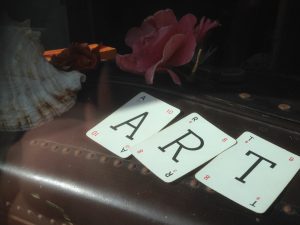Too often, people outside of the art world get confused when confronted with art. They’re afraid that it means something secret, something they don’t understand.
Many times they walk away, not because they don’t like it but because they’re afraid of sounding stupid.
One important way to become successful as an artist, is to help others understand what you’re doing and how it can add value to their lives. For this reason, you want to engage your audience.
Don’t just show the work but also share your artistic journey and showcase your achievements.
I am going to talk about the various ways you can introduce your artwork to other people. Whether you are posting online, giving a gallery tour, or a professional presentation, your words can teach your audience to appreciate your work.
Follow these tips to better connect your art to an audience – even if they have zero understanding of art.
1. Stand in Their Shoes First
Before you start talking too much about how elegant your composition is, understand your audience. The average person has little to no knowledge about art. You need to inspire this person through your work, words, style, and everything possible to make them understand what you do so that they can fall in love with your art.
When attending art fairs for artists, you will meet people who are already interested in listening to you. That is a great advantage because you will have an audience already eager to learn. Some of them may even end up buying your work.
Although they may be ready to listen to you or perhaps they’re already interested in art, only a few really understand anything about art. Apart from simple decoration, they may not be able to see the message, motivation, and spirit behind your work.
One big mistake I see artists making is that they talk too much about HOW they made the work. Save your technical explanations for other artists. If you’re meeting with collectors, focus on the things that they’re interested. Most of them couldn’t care less that you used a gesso base.
Artists are always telling me that their work “speaks for itself.” Here’s the most important takeaway from this artist: it doesn’t. Your work does not speak for itself because the majority of people don’t speak the same visual language as you. It’s part of your job to interpret it for them.
2. Bring Out the Touch and Feel of Your Work
While your art may be fascinating to the eye, not everyone will instantly understand the impact or message you want to convey. Don’t assume that people will get your when they look at it.
One way to prepare is to pretend that a viewer can’t see your piece of art.
Now find words that can make them feel the content without the need to use their vision. Engage their imagination to make them grasp your message. Sometimes, you can describe the effect of a color gradient in the form of texture, scent, or temperature.
Are you passing a warm message or displaying the sharpness of something? Is your work about beauty? Formal aspect? Ideas? Your choice of words will help your audience understand your artwork far better than when they give it a mere stare.
3. Leave Your Ego at Home
It’s sad but true that artists’ egos have killed a lot of art sales before they ever happen.
You may think that you are displaying your knowledge about art while, in reality, you are just bragging. This will kill your audience’s patience and attention.
Instead, an engaging description can include the inspiration behind a specific piece. Why did you choose this color or that shape? What methods did you use to research or design your art? What do you want people to see or learn from your artwork?
Sadly, I have heard too many artists ramble on and on about themselves; how great they are, how the world needs to acknowledge this greatness, how lucky they are to be in the presence of such greatness. And I’ve seen potential collectors yawn in response and move on.
4. Make Your Words Lively
Try not to use a passive voice to describe your art.
When presenting your work, try to help your audience understand that art can do things. For instance, art inspires, remembers, beautifies, educates, and provokes. In such a context, you can make your work more powerful, alive, and accessible. By using engaging language when marketing your art you can connect your intentions with the audience.
And try to refrain from using passive voice words when describing your work. “This tapestry can hang on the wall” is less powerful than, “This tapestry will add warmth and beauty to any room.”
5. Keep It Simple
Try really really hard not to engage in “artspeak.” This is not the audience for post-modern discourse on the subtle history of aesthetics. Use words and phrases that your audience will understand. If you want to include references, give them some background.
Keep your language short and simple. Too many words can make your descriptions lose value and ultimately lose the attention of the very people you want to connect with.
Summary
Creating a piece of art is a skill. Knowing how to speak about that art is also a skill. Both are important to your sales and success as an artist.
